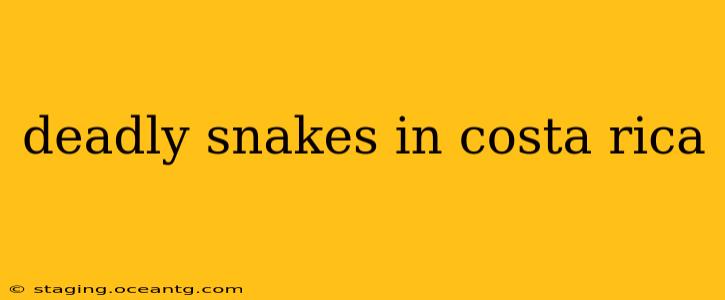Costa Rica, renowned for its breathtaking biodiversity, also harbors a number of venomous snakes. While encounters are relatively rare, understanding the potential dangers and knowing how to avoid them is crucial for any visitor or resident. This guide explores the deadliest snakes found in Costa Rica, their characteristics, habitats, and what to do in case of a bite.
What are the most venomous snakes in Costa Rica?
Costa Rica's venomous snake population is primarily comprised of pit vipers and coral snakes. The most dangerous are generally considered to be the Bothrops asper (fer-de-lance), the Crotalus durissus terrificus (terrific rattlesnake), and various species of coral snakes (Micrurus). While other snakes may inflict painful bites, these three pose the most significant threat due to the potency of their venom and their relatively common occurrence.
What are the characteristics of the fer-de-lance (Bothrops asper)?
The fer-de-lance is arguably Costa Rica's most dangerous snake. It's a large, heavy-bodied pit viper, typically reaching lengths of 4-6 feet, although some individuals can grow larger. Its coloration is highly variable, ranging from light brown to dark gray or even reddish-brown, often with darker markings. Fer-de-lance are ambush predators, often found near human settlements in areas with dense vegetation and rocky crevices. Their venom is hemotoxic, meaning it damages blood cells and tissues, leading to extensive bleeding, swelling, and potential organ damage if left untreated.
What are the characteristics of the terrific rattlesnake (Crotalus durissus terrificus)?
The terrific rattlesnake, while also a pit viper, is easily identifiable by its characteristic rattle at the end of its tail. This rattle serves as a warning signal, but it can sometimes be shed or broken off. They are usually a grayish-brown color with darker crossbands. They are found in a variety of habitats, including dry forests and grasslands. Like the fer-de-lance, their venom is hemotoxic, but it also contains neurotoxic components, affecting the nervous system.
What are the characteristics of coral snakes (Micrurus)?
Coral snakes are slender snakes belonging to the Elapidae family. They possess a brightly colored pattern of red, yellow, and black rings, often used as a warning. Their venom is primarily neurotoxic, affecting the nervous system and leading to paralysis. Encounters are less common than with pit vipers, as they are often more secretive and less aggressive. However, their potent venom makes them a serious threat.
How common are snake bites in Costa Rica?
While statistically, snake bites in Costa Rica are not extremely common, they do occur, especially in rural areas and regions with high biodiversity. The risk is generally low for tourists sticking to well-maintained trails and resorts, but caution is still advised.
How can I avoid snake bites in Costa Rica?
Prevention is key. Here are some tips for minimizing your risk:
- Wear appropriate footwear: Sturdy boots or closed-toe shoes offer protection against snake bites.
- Be aware of your surroundings: Stay alert while hiking in forested areas or grassy fields. Look where you step and place your hands.
- Avoid reaching into crevices or under rocks: Snakes often seek shelter in these areas.
- Stick to marked trails: Staying on established paths minimizes the chances of encountering snakes.
- Don't handle snakes: Even non-venomous snakes can bite if they feel threatened.
- Use caution at night: Many snakes are nocturnal, increasing the chances of encountering them in the dark.
What should I do if I am bitten by a snake in Costa Rica?
If bitten by a snake, remain calm and follow these steps:
- Seek medical attention immediately: This is the most crucial step. Call for emergency services or get to the nearest hospital as quickly as possible.
- Stay still and try to limit movement: This will help slow the spread of venom.
- Try to identify the snake (if possible but don't risk further harm): This information will help medical professionals determine the appropriate antivenom.
- Remove any tight clothing or jewelry: Swelling can occur rapidly.
- Do NOT attempt to suck out the venom: This is an ineffective and potentially harmful practice.
- Do NOT apply a tourniquet: This can actually cause more harm than good.
Costa Rica's natural beauty is undeniable, but understanding and respecting its wildlife, including its venomous snakes, is essential for a safe and enjoyable experience. By following these precautions and knowing what to do in the event of a snake bite, you can minimize your risk and enjoy everything this magnificent country has to offer.
